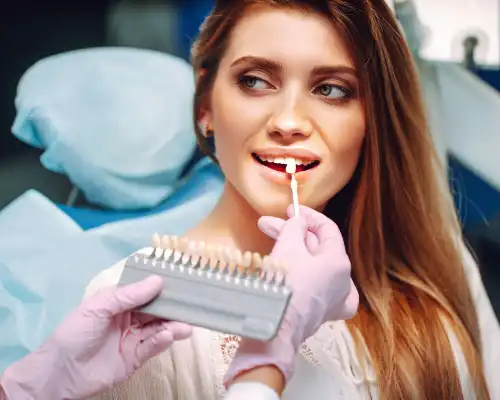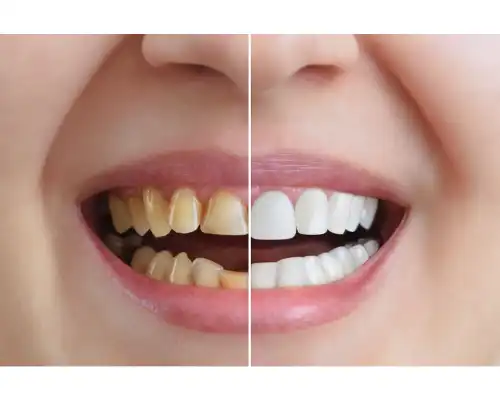Your teeth are known as “pearly whites” but, unfortunately, due to genetics, lifestyle habits, environmental factors, and more, they are often anything but. This is why cosmetic teeth whitening has gained popularity- it offers patients the ability to improve the brightness of their smile and boost their self-confidence.
Cosmetic teeth whitening is one of the most popular cosmetic procedures at Prime Family Dentistry. Dr. Subha Yerabollu employs the Opalescence system, which utilizes both in-office and at-home treatments.
Over the years, this aesthetic treatment has significantly evolved, utilizing innovative techniques and advanced technology to achieve remarkable results. In this article, we will explore the factors contributing to tooth discoloration, the types of cosmetic teeth whitening, and the science behind teeth whitening.
Types of Tooth Stains
Before exploring cosmetic teeth whitening, it’s important to understand the causes of tooth discoloration. There are three primary causes of tooth discoloration:
Extrinsic Stains
Extrinsic stains occur on the surface of the enamel and are usually due to consuming certain foods and beverages. The most common culprits that cause tooth staining include coffee, tea, red wine, and berries. Smoking can also contribute to extrinsic staining.
Intrinsic Stains
Intrinsic stains originate from within the tooth. The most common factors contributing to intrinsic stains include aging, trauma, genetics, and exposure to certain medications during tooth development.
Microscopic Changes
While tooth enamel is white, the underlying dentin is slightly yellow. Over time, microscopic changes occur within the enamel, exposing the dentin. This leads to a gradual yellowing/darkening of the teeth.
Cosmetic Teeth Whitening Techniques
Cosmetic teeth whitening primarily involves the use of bleaching agents, usually hydrogen peroxide or carbamide peroxide, to lighten the color of the teeth. There are two primary types of tooth whitening: in-office professional treatments and at-home treatments.
In-Office Professional Treatments
In-office professional tooth whitening treatments are known for their efficiency and rapid results. The most common in-office whitening treatment involves the use of highly concentrated peroxide gel. The procedure typically follows these steps:

Preparation
The first step is to protect the gums and surrounding tissues to mitigate any potential irritation/inflammation from the bleaching agent.
Application of Whitening Agent
The whitening gel is applied directly to the teeth and activated, typically with a specialized light/laser. This activation enhances the penetration of the bleaching agent into the tooth.
Monitoring
The dental team closely monitors the process, making adjustments as needed to achieve the desired results.
Post-Treatment Evaluation
After completion of the treatment, the dentist will evaluate the results and provide aftercare instructions.
At-Home Treatments
At-home tooth whitening treatments are also highly popular. While they can be effective, these treatments are typically less potent than in-office professional treatments. At-home options include whitening toothpaste, gels, strips, and custom-fitted trays provided by your dentist.
These methods typically take longer to show results compared to in-office professional treatments but provide the convenience of being able to whiten teeth at home instead of having to visit the office.
The Science Behind Cosmetic Teeth Whitening
The active agents used in tooth whitening, hydrogen peroxide (H2O2) and carbamide peroxide (CH6N2O3), work by breaking down into oxygen molecules. These oxygen molecules then enter the enamel and dentin of the teeth, breaking down the long-stained molecules responsible for discoloration.
The process can be simplified into three key steps:
Penetration
The whitening agent penetrates the enamel, reaching the discolored molecules within the tooth structure. This is facilitated by the peroxide molecules breaking down into highly reactive oxygen radicals.

Reaction
The oxygen radicals react with the discolored molecules, breaking them down into smaller, less pigmented fragments. This chemical reaction effectively lightens the color of the teeth.
Removal
The broken-down fragments are removed from the tooth structure, creating a whiter, brighter appearance.
Factors Impacting Teeth Whitening Results
While most patients are satisfied with their teeth whitening results, it’s important to note that there are several factors that can impact the effectiveness and outcome of cosmetic teeth whitening treatments:
Initial tooth color
The initial color of the teeth plays a role in determining the level of whitening that can be achieved. Yellowish teeth typically respond more favorably to whitening treatments compared to teeth that have a brown/gray hue.
Concentration of whitening agent
A whitening gel with a higher concentration of peroxide leads to faster, more significant results. However, it’s important to note that a higher concentration may increase the risk of tooth sensitivity and irritation.
Duration of treatment
Both types of cosmetic teeth whitening techniques require a certain duration to achieve optimal results. It’s important to comply with the recommended treatment schedule for best results.
Tooth sensitivity
Some patients may experience an increase in tooth sensitivity during or after whitening treatments. Typically, this is temporary but may vary among patients.
Post-whitening care
Proper post-whitening care, including maintaining proper oral hygiene and avoiding substances that are known to cause stains, is critical for preserving and prolonging the results of whitening treatments.
Cosmetic Teeth Whitening: An Effective Option for Improving Your Smile
Cosmetic tooth whitening has become a popular, non-invasive option for improving the appearance of teeth. These treatments have transformed smiles and boosted confidence for those seeking a brighter, more radiant appearance.
Tooth whitening offers a personalized approach to achieving a whiter, more youthful smile whether through at-home or in-office treatments. The Opalescence system at Prime Family Dentistry offers a combination of the two to achieve optimal results.

